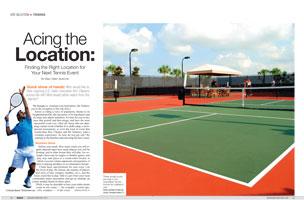
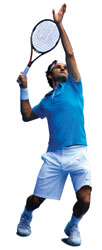 |
| © Nicolas Bernier - Dreamstime.com |
Quick show of hands: Who would like to face reigning U.S. Open champion Kim Clijsters across the net? Who would rather watch from the stands?
We thought so. (And put your hand down, Mr. Federer; you're the exception to the rule here.)
Tennis is riding a wave of popularity, thanks to its heightened profile, the star power of its top players and its many new player initiatives.It's time for you to harness that growth and that energy, and have the most successful event ever. After all, those who are planning a tennis event (whether it's a skills camp, a recreational tournament, or even the kind of event that would draw Mrs. Clijsters and Mr. Federer), want a winning experience. So how do you get one? By starting at the baseline and choosing the best venue.
Numbers Game
Define your needs. How many courts you will require depends upon how many players you will be hosting, and in what format they will play. For example, there may be singles or doubles games, and play may take place in a round-robin format, in which everyone rotates opponents (and partners, if they're playing doubles) or an elimination format.
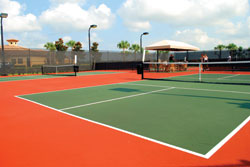 |
| These small courts are built in the QuickStart Tennis format for children's use. Photo courtesy of Fast-Dry Courts, Pompano Beach, FL. |
Create basic specifications for your event. List the level of play, the format, the number of players and style of play (singles, doubles, etc.), and the hours you'd like to play. Talk to a pro from your local community tennis association and get an estimate on courts needed, based on those specs.
While it may be desirable to host your entire tennis event at one venue -- for example, a tennis-specific complex -- if the event will attract a very large number of players, it may only be feasible to identify a number of facilities spread out across the town or city you will be using. Find out how many courts are available, and (most importantly) if any will be busy with other programming at the time of your event.
On the Surface
Next, consider the types of courts available. Tennis courts are commonly classified into two types of surfaces: hard courts and soft courts. Hard courts include asphalt or concrete courts surfaced with acrylic coatings or covered with sheet or roll goods, or with modular surfaces. A hard court may be covered with a cushioned, or resilient, material, which gives it a slightly more bouncy feel during play. Soft courts include clay, fast-dry, grass and synthetic turf, and are generally considered easier on players' back, feet and legs, as well as being cooler during hot weather.
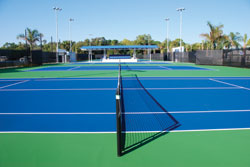 |
| The seating overlooking the courts (visible above the net line) can be used for spectators, team members and personnel, or just for individuals cooling off between games. Photo courtesy of Fast-Dry Courts, Pompano Beach, FL. |
The choice of surface should be dictated by a variety of considerations: the facilities available, player preferences and needs, budgetary considerations and availability of maintenance personnel (since, for example, clay and fast-dry courts need to be brushed after each match, and fast-dry courts require daily watering to keep them in condition). Above all, a facility should be well-maintained, safe and consistently playable.
"When choosing a venue for a tennis event, every event planner must consider their specific needs and choose a facility that best suits those needs," notes Chad Luttrell of Mondo USA in Ft. Myers, Florida. "Whether planning for a professional or NCAA tournament, a special-needs event or a multi-day tennis camp, choose the playing surface that has the best combination of performance, comfort, safety and durability."
The Court Itself
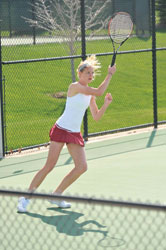 |
| Younger players, known in tennis parlance as juniors, require teh same size courts as an adult for regulation play. Photo courtesy of URS Corporation, Grand Rapids, MI. |
All courts, whether public or private, for recreational play or for competition, must be built according to the rules promulgated by the International Tennis Federation (ITF) in London. The following information is excerpted from The Rules of Tennis, published periodically by the ITF, of which the United States Tennis Association (USTA) is a member:
The court shall be a rectangle, 78 feet (23.77m) long, and for singles matches, 27 feet (8.23m) wide. For doubles matches, the court shall be 36 feet (10.97m) wide. The court shall be divided across the middle by a net suspended by a cord or metal cable which shall pass over or be attached to two net posts at a height of 3-1/2 feet (1.07m). The height of the net shall be 3 feet (0.914m) at the center where it shall be held down tightly by a strap.
Those standard dimensions will be the same whether the court is built in a back yard or at Wimbledon; however, courts that are built for those higher levels of competition have more space outside the playing area to accommodate line judges, umpires, etc. Choose a facility that complies with all current rules and regulations. A list of governing bodies and informational organizations is included with this article.
Base model, or bells and whistles?
A tennis facility can be equipped with the basics that players need -- a court, a net and so on -- or it can have some (or many) extras.
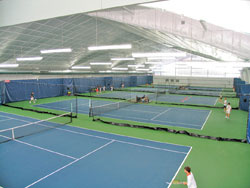 |
| Having an indoor venue as a backup in case of rain can be an incredibly smart move, depending upon the geography and weather conditions in your site. Photo courtesy of ICA, North Salem, NY. |
The court fence defines the playing area and keeps balls in play. Beyond that, it can provide an element of privacy to the players if windscreen (the dark-colored mesh fabric hung on the fence) is used. In addition to reducing the impact of wind on play, windscreen also cuts down on distractions, something players appreciate. A 10' fence will be suitable to most hard courts where balls tend to bounce higher, while an 8' fence will do for a soft court. Fencing can go all around the court, or can be only behind each baseline and partially along the sidelines. Having lights on the court extends the playing day and makes it possible for a court to accommodate more play. Lighting is necessary for professional matches, with increased levels of light required for higher levels of competition.
Players will appreciate a lounge area, or a furnished place to relax between matches, or until their court becomes available. Benches, shade shelters, tables and so forth are examples. A drinking fountain, concession stand or soda machine can add to the comfort level. Players will also appreciate lockers or other storage facilities, since competitive players travel with changes of clothing, multiple racquets and so on. If no rest rooms and showers are nearby, changing booths can be created for players using special drapes that fit around umpire chairs. Spectator facilities may be necessary as well.
Indoor or outdoor? It depends upon the predictability of your weather, and whether or not you're able to reschedule if there's a rainout. Many planners of outdoor events like to have a 'Plan B' - an indoor venue on standby, just in case.
The Competitive Type
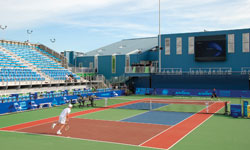 |
| This stadium court is an excellent venue for a match between high-profile players, or the final of a municipal tournament. Photo courtesy of ICA Sports, North Salem, NY. |
There is a great deal of variety among tennis events, and these differences will shape a planner's choice of venue. For example,there are "Play for the Cure" weekends, in which tennis players collect sponsorship money and play a set number of hours in order to raise funds for a cause such as cancer research. This type of event, which is recreational in nature, could be played on a large public facility with very little officiating. However, a tournament or exhibition which draws big-name players may be televised and will have different requirements with regard to lighting, space for cameras and commentators, and so forth. In this case, look for equipment including umpire chairs, scoreboards (manual and electronic versions are available), net tensioning systems to set the net precisely, and electronic line calling systems.
Happy Campers
If your event is a tennis skills camp,your teaching pros will need certain amenities. Seek facilities with multiple electrical outlets. You'll need them for plugging in ball machines and video cameras (the best camps record players in order to provide performance analysis). Remember that the more electrical outlets you have, the fewer extension cords you'll need (meaning less of a tripping hazard). Pros may also want loudspeakers or bullhorns to help address large groups on multiple courts.
Alex Levitsky of Global Sports & Tennis Design Group in Fair Haven, New Jersey, notes that if a facility is to host a sports camp, "it is essential that it also include practice walls and volley alleys, as well as meeting rooms and classrooms. Depending upon whether this is a full-day camp or a sleep-over camp, other facilities might include dormitories and a cafeteria."
Fitness and Fun
One very popular fitness program among tennis players is Cardio Tennis, a patented workout program that uses aerobic exercise combined with tennis drills and high-energy music. The program can range from light exercise to higher-intensity workouts where participants can track their own fitness levels through use of wearable heart monitors. Ask the instructing pro(s) what is needed in terms of equipment, power outlets, etc.
Kid Stuff
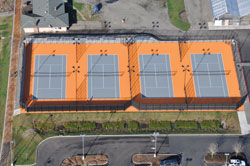 |
| These courts at a local public high school would make an excellent venue for a multi-match event. Note the lighting for night play as well as the divider fencing which will help contain balls to the court on which play is occurring. Photo courtesy of Atlas Track & Tennis, Tualatin, OR. |
It used to be that kids learned to play tennis on the same courts adults use. These days, many teaching pros are likely to use what is known as the QuickStart Tennis Format to help get young children used to the game. QuickStart Tennis (QST for short) uses shorter courts, lower nets and low-compression balls, making it easier to pick up the skills. Temporary short courts can be set up on regular facilities. Information on QSTand equipment is available through the USTA (www.usta.com).
Wheelchair Tennis
If your event will host wheelchair tennis play, make sure it's accessible. According to Jeremiah Yolkut of the USTA's Competitive Play and Technical Programs division, "While it's standard for many facilities to have 42-inch wide gates, you want to have a wider opening for players in wheelchairs because of what we call the camber, or the angle in the wheels that you'll see in an athletic wheelchair. If your gate has a 48-inch wide opening, you don't have to take a wheel off the chair to get it through the gate." Wheelchair tennis tends to attract spectators who may have mobility limitations; seating and conveniences should be accessible.
The Setting
Consider parking, space for vendors, spectator conveniences, press facilities and more. If the venue does not have a first-aid tent or office, it must be accessible to emergency personnel.
Things to Remember
All athletic events require planning. Don't overlook the basics including permitting and insurance (for all activities), transportation (players and spectators, if necessary) and permission/sanctions from any applicable governing body. If your event will require officials, reserve their time in advance. The local community tennis association or the appropriate section of the USTA can help point you in the right direction.
Tennis is a fun and challenging game with a rich history and a bright future. Make sure your event contributes to the tradition by serving up an ace.

